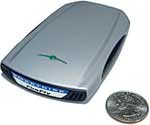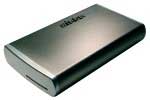MyMac Labs reviews two very different hard drives

SmartDisk FireFly 20 GB
SmartDisk Corp.
http://www.smartdisk.com
US $ 179.99

Wiebe ToughTech 800
Wiebe Tech
http://www.Wiebetech.com
US $ 119.00 (case only)
US $ 309.95 (250 GB)
Kia or Escalade?
Mini Cooper or Dodge Ram dual-wheel V12 pickup truck?
If you are in the market for a hard drive, you need to make some decisions. You’ll need to decide how much capacity do you want or need? Portable? Internal? External but not portable? What kind of performance trade-offs must you make?
SmartDisk and Wiebe Tech have taken two radically different approaches to hard drive enclosures.
SmartDisk has recently introduced one of the most compact external hard drives available. The 20GB FireFly is smaller than an iPod, or a deck of playing cards. I’ve got small hands, and the FireFly fits in the palm of my hand with room to spare. You’d be well advised to put a label with your name and address on the FireFly, as it’s small enough that you could overlook it while packing.
Even thought the drive weighs only 3.3 ounces, the FireFly’s no powderpuff; the case is magnesium, and appears to be plenty strong to withstand the rough and tumble of life in a computer bag. Two rubberized grips that run along each side make it easy to handle without slipping.
The FireFly uses a small USB 2 connector, located on the rear side of the case to keep size down. Choosing USB 2 has some performance penalties, but this tiny connector keeps the case thickness as low as possible. Even though USB 2 allows theoretical transfer speeds up to 480 Mbps, most implementations don’t get anywhere near those speeds. Of course, the same is true for FireWire, but most Macs have better FireWire transfer rates than USB 2 transfer rates. If SmartDisk had chosen FireWire 400 or 800 instead of USB 2, the power requirements would have gone up, and the larger connector size would have increased the minimum case thickness. The little FireFly needs no external power supply, as it’s bus powered. This clean and simple approach trades some speed for convenience, which is important when competing against the ever-cheaper and smaller USB flash drives. The main caveat for a bus-powered hard drive is that you should attach it to either a powered USB hub, or to a USB port on the computer itself. USB ports on a monitor or keyboard may not provide enough power.
How does the 20 GB FireFly perform?
The Weeks division of MyMac labs tested the loaner FireFly on a dual 2.0 GHz PowerMac, with 2 gigs of RAM. The drive was connected to one of the high-speed USB ports on the Power Mac case. We used Xbench 1.1.3 for testing.
Results 27.27
System Info
Xbench Version 1.1.3
System Version 10.3.5 (7M34)
Physical RAM 2048 MB
Model PowerMac7,2
Processor PowerPC 970×2 @ 2.00 GHz
L1 Cache 64K (instruction), 32K (data)
L2 Cache 512K @ 2.00 GHz
Bus Frequency 1 GHz
Video Card ATY,RV350
Drive Type TOSHIBA MK2004GAL
Disk Test 27.27
Sequential 20.23
Uncached Write 38.39 16.00 MB/sec [4K blocks]
Uncached Write 37.17 15.22 MB/sec [256K blocks]
Uncached Read 8.24 1.30 MB/sec [4K blocks]
Uncached Read 42.67 17.24 MB/sec [256K blocks]
Random 41.83
Uncached Write 42.23 0.63 MB/sec [4K blocks]
Uncached Write 37.03 8.35 MB/sec [256K blocks]
Uncached Read 44.54 0.29 MB/sec [4K blocks]
Uncached Read 44.47 9.15 MB/sec [256K blocks]
Clearly, the small FireFly shows the inherent limitations in small drives and USB 2 connections. The FireFly uses a 1.8†mechanism made by Toshiba. While it’s very quiet and compact, a (physically) small drive doesn’t have the ability to pump data at the same rate as do larger drives.
SmartDisk’s product literature positions the FireFly as the smart alternative to USB flash drives. These little gadgets are becoming more and more common, being used transferring small numbers of files (less than CD capacity) between computers. I just bought one for myself last week, at a CompUSA weekend special.
I paid $24.95 (after rebates) for a 256 MB Lexar JumpDrive Secure flash drive that retails for $55.99. How does the Lexar JumpDrive compare with the FireFly’s performance?
Disk Test 10.86
Sequential 9.95
Uncached Write 8.85 3.69 MB/sec [4K blocks]
Uncached Write 8.81 3.61 MB/sec [256K blocks]
Uncached Read 8.24 1.30 MB/sec [4K blocks]
Uncached Read 18.40 7.43 MB/sec [256K blocks]
Random 11.96
Uncached Write 5.01 0.08 MB/sec [4K blocks]
Uncached Write 9.96 2.25 MB/sec [256K blocks]
Uncached Read 159.71 1.05 MB/sec [4K blocks]
Uncached Read 35.18 7.24 MB/sec [256K blocks]
This is obviously quite a bit slower than the hard-drive based FireFly. I wouldn’t want to use the Lexar for moving gigabytes of files around. For the odd couple o’ dozen megabytes, the little Lexar is quite handy. You just plug it into an open USB port; no cable needed.
SmartDisk is right about the lower bang for the buck for flash drives compared to the FireFly. I paid $25 (after rebates!) for a 256 meg (1/4 gig) flash drive. That comes to $100 dollar per gigabyte!
The FireFly retails for $180, and the lowest prices I was able to find was $169. That prices out at $8.45 per gigabyte.
Clearly, if you need access to more than a few hundred megs of files while on the road, the hard drive based FireFly is a better deal, both for economics and performance, if not convenience. Its performance could be better, but FireWire would raise the size and cost of the unit. From the standpoint of portability, the FireFly is about as small as you can get.
At the opposite end of the spectrum is the Wiebe Tech ToughTech 800. This is the Dodge Ram of hard drive enclosures. Wiebe has pulled out the stops to make this external drive case the most rugged you can find. The main selling point of this drive is the tough case, and the FlexMount rubber doughnut shock mounting of the hard drive itself. Has Jim Wiebe talked to the Army about supplying this case to soldiers in the field…?
I own a Wiebe DuoGB external case (full disclosure here), and it’s fairly well constructed. But the ToughTech puts the DuoGB enclosure to shame; the ToughTech case is far more rigid, and the drive itself is better mounted. I really wanted to drive my car back and forth over the ToughTech while transferring data, but didn’t want to have to try to explain the Michelin tread marks on the case when I returned the review unit. I’ll bet it would have worked flawlessly even with my BMW sitting on top of it…
As with most other Wiebe enclosures, you can purchase the ToughTech as an empty case, and supply your own 3.5†ATA drive. The review unit supplied to MyMac Labs came with a Hitachi 250 GB mechanism, retailing for $309.95. With bare hard drive price running around $1 per gig, you may be able to save a few dollars by buying the bare case from Wiebe and finding a drive separately.
I opened the case to check out the so-called FlexMount shock mounting, and came away impressed. The build quality is great, and the four big blue rubber doughnuts are very visible. Push, press and bump on the ends of the drive, and watch the doughnuts absorb any shock. Again, I reluctantly did not abuse the drive, but the mounting arrangements and case appear able to take a lot of hard use. To be sure, the usual caveats about not jostling the drive when in actual operation still apply. Don’t plan to use the ToughTech while perched on the turret of a moving Abrams M-60 battle tank. Anti-tank rounds may penetrate the ToughTech case. Simply wait until the tank come to a stop!
The review unit had dual FireWire 800 connectors. While FireWire 800 is not twice as fast as FireWire 400, it’s noticeably faster. Here are the X Bench results:
Disk Test 101.56
Sequential 89.63
Uncached Write 102.77 42.84 MB/sec [4K blocks]
Uncached Write 101.00 41.36 MB/sec [256K blocks]
Uncached Read 55.38 8.77 MB/sec [4K blocks]
Uncached Read 144.16 58.25 MB/sec [256K blocks]
Random 117.14
Uncached Write 125.73 1.89 MB/sec [4K blocks]
Uncached Write 120.06 27.08 MB/sec [256K blocks]
Uncached Read 101.77 0.67 MB/sec [4K blocks]
Uncached Read 124.41 25.60 MB/sec [256K blocks]
That’s solid performance! Wiebe incorporated the latest Oxford OXUF 922 FireWire 800 bridge chip. For comparison, MyMac Labs’ test of the LaCie FireWire 800 Big Disk showed X Bench Disk Test results of 88.6, tested on a dual 1.4 Power Mac.
You’re not going to cart this drive around to swap files between home and work. The ToughTech is heavy, no doubt about it. Wiebe’s spec sheet doesn’t list the weight, but it’s heavier than you’d expect from simply looking at it. The old Burger King slogan “It takes two hands to handle a Whopper…†came to mind the first time I picked up this unit!
Do you need this much protection in a drive? Only you can decide. Rest assured this unit won’t blow over if the wind comes up! Don’t bounce ANY drive around while in use! But, if you do, the ToughTech will protect you better than any other drive enclosure I’ve seen. The ToughTech is a quality unit; it’s at least the equal of the LaCie Big Disk. The performance is superior, as well.
The SmartDisk FireFly and the Wiebe ToughTech serve different market niches. Not everyone needs a tiny transportable hard drive that costs more than a USB flash drive but performs much better. Not everyone needs an industrial-strength shock mounted drive case. But for their market segments, the SmartDisk FireFly and the Wiebe ToughTech are highly recommended.
ToughTech MyMac rating 5 out of 5
SmartDisk MyMac rating 5 out of 5

Leave a Reply
You must be logged in to post a comment.